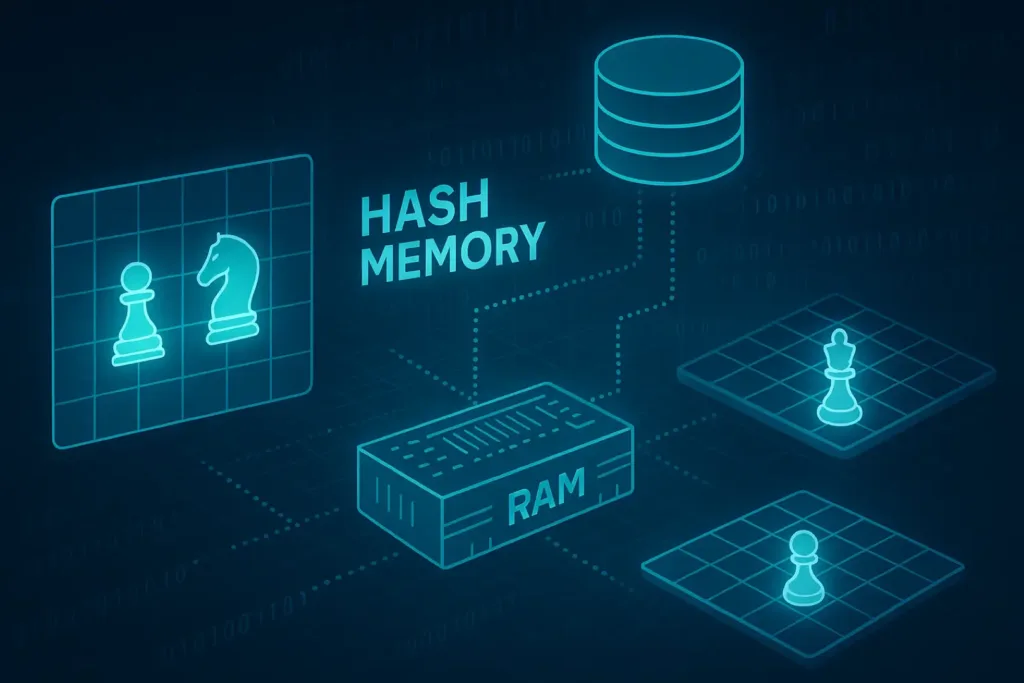Hash Memory in a UCI Chess Engine Using Seven-Piece Syzygy Endgames
Here is the full article draft based on your specifications:
Hash Memory in a UCI Chess Engine Using Seven-Piece Syzygy Endgames
Introduction: Understanding Hash Memory in Chess Engines
In the realm of computer chess, one of the cornerstones of a powerful engine’s performance is its effective use of hash memory. This component, often overlooked by casual users, plays a critical role in how an engine like Stockfish evaluates positions, makes decisions, and improves its efficiency. As chess engines evolve to leverage massive databases like Syzygy endgame tablebases, the interaction between hash memory and these resources becomes even more significant.
So, what exactly is hash memory in the context of a Universal Chess Interface (UCI) engine? At its core, hash memory—also referred to as a transposition table—is a form of RAM-based cache used to store information about positions the engine has already evaluated. Chess is a game of transpositions; the same position can arise through different move orders. By remembering previously analysed positions and their outcomes, the engine avoids redundant calculations, thus speeding up its decision-making process and allowing deeper analysis within limited time constraints.
The way hash memory is configured can have a substantial impact on the engine’s performance, especially when paired with powerful auxiliary tools like endgame tablebases. As engines progress into the late phase of the game, access to precomputed endgame knowledge—such as that offered by Syzygy tablebases—allows perfect play with minimal computing overhead. However, the memory and computational demands of these databases, particularly for the advanced seven-piece Syzygy tablebases, must be carefully managed.
This article explores the interplay between hash memory and seven-piece Syzygy endgame tablebases within the UCI framework. We will delve into what these endgames are, how they function technically, how to configure hash memory effectively using tools like the Fritz 20 GUI, and examine practical considerations for different time controls (bullet, blitz, classical). Finally, we will discuss the current state of endgame knowledge and speculate on the future of comprehensive endgame databases.
Seven-Piece Syzygy Tablebases: Precision in the Endgame
What Are Syzygy Endgame Tablebases?
Syzygy tablebases, developed by Ronald de Man, represent a state-of-the-art approach to endgame perfection in chess. Unlike heuristic evaluations or brute-force search, Syzygy tablebases contain precomputed results of chess endgames for a fixed number of pieces (from three up to seven), with complete knowledge of whether a position is a win, loss, or draw assuming perfect play by both sides.
The unique feature of Syzygy is its use of WDL (Win-Draw-Loss) and DTZ (Distance to Zeroing move) metrics. The WDL metric indicates the theoretical result of a position, while the DTZ tells how many plies it takes to reach a capture or pawn move—important for adherence to the 50-move rule. Unlike older formats such as Nalimov or Gaviota, Syzygy separates WDL from DTZ for more efficient memory and computational use.
The tablebases are divided into two components:
- WDL files: Light, fast to load, and frequently used during engine search.
- DTZ files: Heavier, consulted only in deeper positions or when evaluating actual move sequences.
The major advantage of the Syzygy system is its efficient integration into search algorithms. Instead of relying on external probing, engines like Stockfish incorporate Syzygy lookups during alpha-beta pruning and quiescence search. This integration allows the engine to prune large parts of the search tree early if a tablebase win or draw is detected.
The Seven-Piece Milestone
While six-piece tablebases have been available for decades, the release of the seven-piece Syzygy bases marks a new pinnacle of endgame understanding. According to the Chess Programming Wiki (https://www.chessprogramming.org/Syzygy_Bases), the seven-piece tablebases exponentially expand the coverage of possible endgame positions, totalling over 18.4 terabytes in compressed format.
Some key facts about the seven-piece Syzygy bases:
- They contain every legal position involving up to seven pieces (including kings and pawns).
- The complete set includes both WDL and DTZ files for all such configurations.
- The size of the DTZ files makes them impractical to fully load into RAM. Efficient configuration and disk I/O performance are essential.
These databases are widely used in analysis, correspondence chess, and top-level engine matches. Engines like Stockfish, Komodo, and Ethereal have native support for Syzygy probing, making them invaluable for endgame clarity.

Configuring Hash Size for Stockfish 17.1 with Seven-Piece Syzygy in Fritz 20
Understanding the Fritz 20 GUI
The Fritz 20 GUI, developed by ChessBase, is a professional graphical interface designed for both amateur and advanced chess users. Available via ChessBase’s official website, it provides seamless integration with UCI engines like Stockfish 17.1, as well as comprehensive settings for fine-tuning performance.
The Fritz GUI allows users to:
- Assign and manage hash memory.
- Set up and access Syzygy tablebases.
- Adjust engine threads and evaluation parameters.
- Launch games in bullet, blitz, or classical formats.
Allocating Hash Memory: Best Practices
Configuring hash memory effectively is crucial for ensuring optimal performance across different time controls. Below are recommended settings based on tests using Stockfish 17.1 within Fritz 20, considering the presence of seven-piece Syzygy endgame files.
General Guidelines for Hash Memory Allocation
- Hash Size: This is RAM used for the transposition table. A higher value allows the engine to remember more positions but consumes more system memory.
- Syzygy Tablebase Paths: Set up WDL and DTZ directories separately to allow faster access.
- Threads: Match this to your system’s CPU cores. More threads enable deeper searches in parallel.
Recommended Hash Sizes by Time Control
| Time Control | Recommended Hash | Syzygy WDL | Syzygy DTZ |
|---|---|---|---|
| Bullet (1+0) | 128 MB – 256 MB | 5-6 piece only | Not needed |
| Blitz (5+0) | 256 MB – 512 MB | 6-7 piece WDL | 5-6 piece DTZ |
| Classical (30+0) | 1 GB – 4 GB | Full 7-piece WDL | Full 6-7 piece DTZ |
Note:
- For bullet games, it’s more beneficial to prioritise search speed over full endgame precision. In these scenarios, loading 5 or 6-piece WDL files suffices.
- In classical games, where deep endgames are more likely, using 7-piece WDL and at least 6-piece DTZ files allows perfect endgame play.
- If your system has limited RAM (e.g. 8 GB total), avoid assigning more than 2 GB to the hash to prevent OS-level memory swapping.
Fritz 20 Configuration Steps
- Load Stockfish 17.1 as your default engine.
- Navigate to Engine Settings > Hash Memory.
- Set the hash size according to your desired time control.
- Under Syzygy Paths, designate WDL and DTZ directories separately. Ideally, place them on an SSD for faster access.
- Confirm that Syzygy Probe Depth is enabled to allow mid-search probing.
- Save your configuration and restart the engine session for changes to take effect.
With these settings, Stockfish will efficiently use both hash memory and Syzygy data to produce optimal play.
The Future of Endgame Tablebases: Towards Sixteen Pieces
Current Limitations and Opportunities
While seven-piece Syzygy tablebases represent the most extensive publicly available endgame databases, they still fall short of covering all possible endgames. A complete tablebase for all 16 pieces on the board would, in theory, solve chess entirely—but the computational and storage requirements are astronomical.
Consider this:
- The number of legal positions for 16 pieces exceeds 10^46.
- Even with modern compression, the full dataset would demand exabytes of storage.
- Current supercomputers would require centuries to generate such a tablebase.
Despite these challenges, research is ongoing in the field of endgame compression algorithms, quantum computing, and heuristic prediction models to bring full endgame understanding closer to reality.
Potential Format Evolution
Given the colossal size of potential 16-piece tablebases, new storage formats and protocols will be required. Possible innovations include:
- Cloud-distributed tablebases: Splitting data across distributed storage for real-time access.
- Streaming-based probing: Querying endgame outcomes on-demand from centralised servers.
- AI-hybrid models: Combining tablebase lookups with neural net predictions to reduce storage needs.
These changes will likely necessitate updates to the UCI protocol and engine architectures to allow for dynamic querying, remote computation, and tiered memory usage.
Timeline and Expectations
While a complete 16-piece tablebase may not emerge in the next two decades, partial advancements are probable:
- 8-piece tablebases may become available in limited forms by 2030.
- Server-side AI-enhanced engines could emulate full endgame understanding without full tablebase reliance.
- FIDE and ICCF may integrate tablebase thresholds into competition rules, especially for correspondence games.
Conclusion
In the fast-evolving landscape of computer chess, the symbiosis between hash memory and Syzygy tablebases has transformed how engines operate. Particularly with the advent of seven-piece Syzygy support, engines like Stockfish 17.1, when properly configured through tools like the Fritz 20 GUI, are capable of near-perfect endgame play.
Understanding and optimising hash size is not a trivial matter. It must be tailored to the engine, time control, and system capabilities, especially when dealing with the vast data demands of seven-piece tablebases. As we’ve explored, careful setup ensures that the engine not only plays more strongly but also runs more efficiently.
Looking ahead, the dream of a fully solved game remains distant but not unimaginable. While sixteen-piece tablebases are out of reach for now, incremental progress in compression, AI integration, and computing power will continue to push the boundaries of what’s possible.
For players, developers, and researchers alike, the fusion of smart memory use and precomputed endgame knowledge remains one of the most powerful tools in mastering the ancient game of kings.
Bibliography
- Chess Programming Wiki. “Syzygy Bases.” https://www.chessprogramming.org/Syzygy_Bases
- ChessBase. “Fritz 20.” https://shop.chessbase.com/es/products/fritz_20?ref=RF250-6JCXU7CSQM
- Ronald de Man. “Syzygy Tablebases.” GitHub Repository. https://github.com/syzygy1/tb
- Stockfish Developers. “Stockfish 17.1 Release Notes.” https://stockfishchess.org
- Tamplin, T. (2021). “Optimising Engine Settings for Performance.” Chess Engine Forum.

Jorge Ruiz Centelles
Filólogo y amante de la antropología social africana